Paddle boarding can be a fantastic way to enjoy the water and get some exercise. Still, wind conditions can significantly impact your experience. This guide explores the ideal wind for paddle boarding, providing insights into what is a good wind speed for paddle boarding and addressing various wind speed for paddle boarding recommendations.
Whether you’re a seasoned paddler or just starting, understanding wind conditions can help ensure a safe and enjoyable outing. Let’s investigate these questions and discover the perfect wind conditions for your next paddle boarding journey!
Ideal Wind for Paddle Boarding: The Basic
Paddle boarding is a fantastic aquatic activity that allows you to explore scenic waterways, exercise, and enjoy the peacefulness of nature. However, wind can significantly impact your paddle boarding experience, so it’s crucial to understand paddle board wind conditions before heading out on the water.
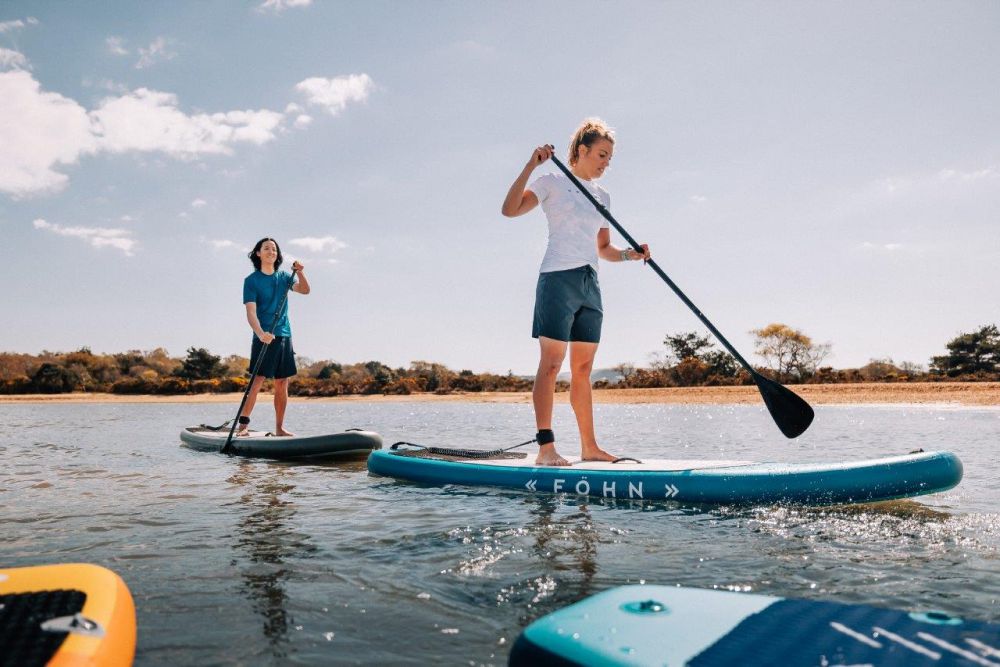
Understanding Wind Terminology
Before delving into the ideal wind for paddle boarding, it’s essential to establish a basic understanding of wind terminology:
- Beaufort Wind Scale: This internationally recognized scale categorizes wind speeds and their corresponding descriptions and effects.
- Offshore Wind: Wind blowing directly away from the shore, pushing paddlers out to sea.
- Onshore Wind: Wind blowing directly towards the shore, pushing paddlers towards the shore.
- Crosswind: Wind blowing perpendicular to the shoreline complicates maintaining a straight course.
Impact of Wind on Paddle Boarding
Wind can be a significant factor for paddle boarders, influencing their experience in several ways:
- Stability: Strong winds can whip up the water, creating choppy conditions that test your balance and stability, making it more challenging to stay upright on the board.
- Maneuverability: Wind can act like an invisible current, pushing the board off course and making it challenging to maintain a straight line or maneuver around obstacles.
- Effort: The constant battle against the wind requires more physical effort and exertion from the paddler, leading to quicker fatigue and potentially impacting the overall enjoyment of the activity.
Best Wind for Paddle Boarding
Regarding paddle boarding wind conditions, the best wind speed for paddle boarding depends on your experience level. Here’s a guide to good wind for paddle boarding, categorized by skill level:
- Beginners: For those new to paddle boarding, safe wind speed for paddle boarding is paramount. 5 knots or less (approximately 9 kilometers per hour (kph) or 5.6 miles per hour (mph)) provides ideal flat water conditions, allowing you to learn and maneuver comfortably.
- Intermediate: As your skills progress, you can handle slightly more wind. Up to 10 knots (around 18 kph or 11.2 mph) is manageable for intermediate paddlers. This wind speed may create gentle ripples but shouldn’t significantly impact your paddling.
- Advanced: With experience comes the ability to navigate 10 to 20 knots (approximately 18 to 37 kph or 11.2 to 23 mph). At this level, skilled paddlers can utilize the wind to their advantage, practicing techniques like downwinding, where you ride the wind-generated waves.
- Highly Advanced: Winds exceeding 20 knots (around 37 kph or 23 mph) are only suitable for highly advanced paddlers with extensive experience and specialized equipment. These conditions can be dangerous and should only be attempted with proper training and caution.
Max wind speed for paddle boarding is about more than just skill level. Understanding the ideal wind for paddle boarding conditions and planning accordingly can ensure a safe and enjoyable experience. It is also advisable to check the max wind for paddle boarding in your specific location and consider factors like water body size, the presence of waves, and your comfort level before heading out.
How Much Wind is Too Much for Paddle Boarding?
What is too much wind for paddle boarding? Wind speeds exceeding 15 knots (17 mph, 27 km/h) are considered too much wind for paddle boarding. These conditions create rough water with large waves, making paddling extremely difficult and potentially dangerous. It’s strongly advised to avoid paddle boarding in such conditions, especially for beginners.
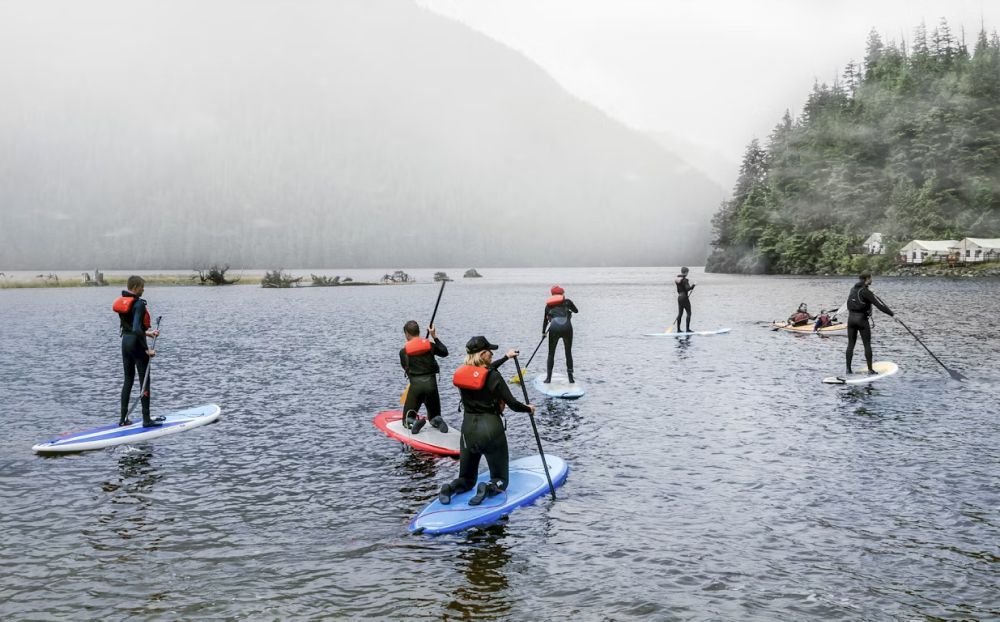
But what wind speed is safe for paddle boarding in particular? As paddle board wind speed increases, so does the effort required to maintain control and direction. Here’s a breakdown of how wind speed impacts paddle boarding:
- Wind speeds of 7 knots (about 8 MPH or 13 km/h) and under: While still manageable, you’ll start to feel the wind pushing against you, requiring more effort to paddle, particularly when going against the wind. This is the best wind conditions for paddle boarding for beginner and intermediate levels.
- Wind speeds of 8-10 knots (around 9-12 MPH or 14-19 km/h): This range presents a noticeable challenge, especially for beginners. Paddling against the wind becomes significantly more complicated, and staying balanced can require more focus.
- Wind speeds of 11-13 knots (approximately 13-15 MPH or 21-24 km/h): At these speeds, paddling becomes a significant workout, and upwind paddling might be challenging or even impossible. It’s advisable to avoid venturing out for leisure paddling in these conditions, especially for beginners.
- Wind speeds exceeding 14 knots (about 16 MPH or 26 km/h): This is generally considered what is too much wind for paddle boarding for most individuals. Strong winds can create choppy waters, making it difficult to maintain balance and control. Additionally, the wind can quickly push you off course, potentially leading to dangerous situations.
By understanding the ideal wind for paddle boarding and the impact of different paddle board wind speeds, you can make informed decisions about when and where to paddle. If you need clarification on the conditions, it’s always best to wait for a calmer day.
Now that we’ve established wind speed limitations, let’s delve into the essential preparations for a successful paddle boarding adventure on a windy day.
Preparing For a Windy Day Out
Paddle boarding is a fantastic way to enjoy the outdoors and get some exercise. However, when the wind picks up, it can significantly affect your experience, making it more challenging and potentially even dangerous. While calm conditions are ideal for beginners, more experienced paddlers can still enjoy the water on windy days with proper preparation and awareness.
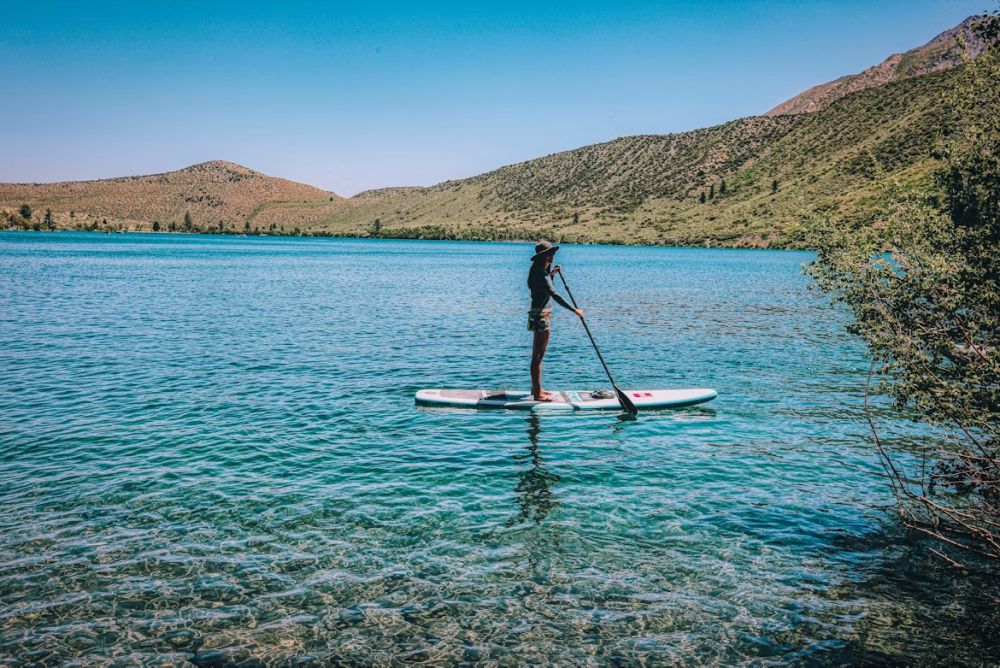
1. Check the Wind Forecast
Before setting out, always check the wind forecast for your chosen location. Numerous websites and apps provide detailed wind speed and direction information. Ideally, aiming for ideal wind for paddle boarding would be best, which generally falls below 10-12 knots. If the forecast predicts stronger winds, postponing your paddling adventure for another day is best. Remember, underestimating the wind’s power can quickly turn a fun outing into a frustrating and potentially dangerous situation.
2. Leash and PFD
On any paddle boarding trip, wearing a PFD is crucial. Still, it becomes even more critical on windy days. Also, always paddle with a leash that connects you to your board. If you fall off in rougher conditions, a leash prevents your board from drifting away, making it easier to get back on.
3. VHF Radio for Offshore Paddling
Consider carrying a VHF radio for paddle boarding in wind, especially if you plan to venture far from shore. This allows you to communicate with other vessels and local authorities if you encounter difficulties or emergencies on the water. While not always necessary for sheltered locations, a VHF radio provides peace of mind, knowing you can call for help.
4. Stay Alert
Be conscious of your surroundings at sea and pay close attention to wind conditions for paddle boarding. Wind patterns can change rapidly even if the forecast seemed favorable when you launched. If you encounter unexpected strong winds, head back to shore immediately. It’s always better to prioritize safety and err on the side of caution.
Wind Conditions for Paddle Boarding Matter
Wind can significantly impact your paddle boarding experience. Headwinds, blowing directly against you, require greater effort to maintain forward momentum. Tailwinds, pushing you from behind, might seem ideal for effortless gliding.
Still, they can also decrease control and make steering difficult. Crosswinds can push your board sideways, requiring constant adjustments to maintain your course.
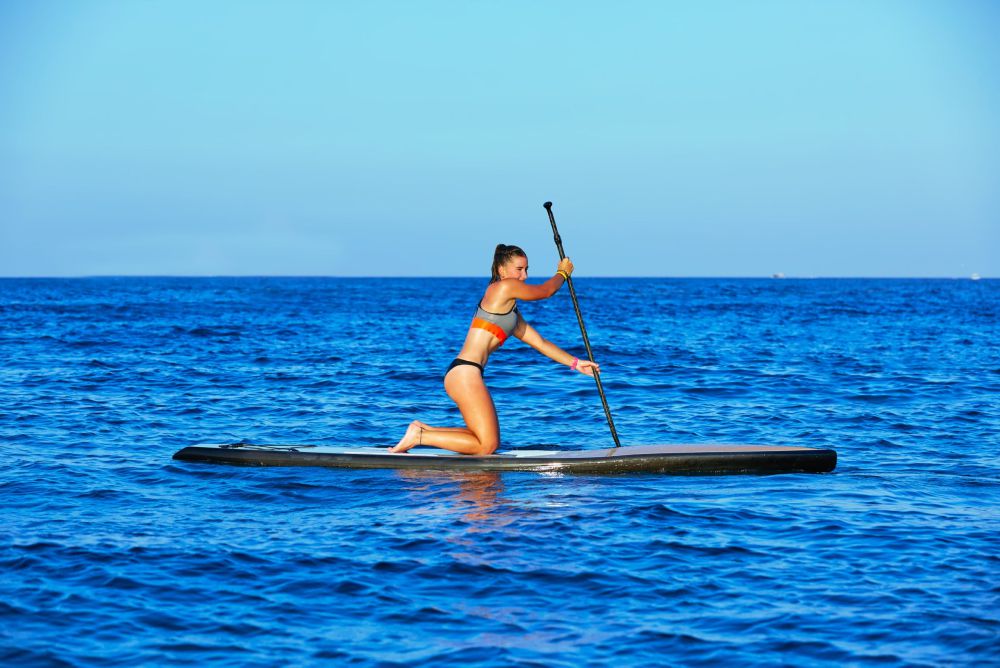
While paddle board in wind can be exhilarating for experienced paddle boarders, it demands careful planning and safety precautions. Being aware of wind conditions for paddle boarding and adapting your paddling strategy can ensure a safe and enjoyable experience on the water, even when the wind picks up.
=> Curious about how fast you can go on a paddle board under these conditions? Discover techniques to maximize your speed and efficiency regardless of the wind direction.
Adequate preparation is essential for venturing out on a windy day. Sometimes, however, the winds can prove more vital than anticipated. If you are battling unexpectedly strong winds, it’s time to shift strategies. Let’s delve into effective paddling techniques for excessively windy conditions.
How do You Paddle When it is Too Windy?
Wind and paddle boarding can be delightful, offering a refreshing breeze and gentle propulsion. However, strong winds can quickly transform a leisurely outing into a challenging experience. Here are some strategies to help you navigate windy conditions while ensuring a safe and enjoyable paddle board adventure.
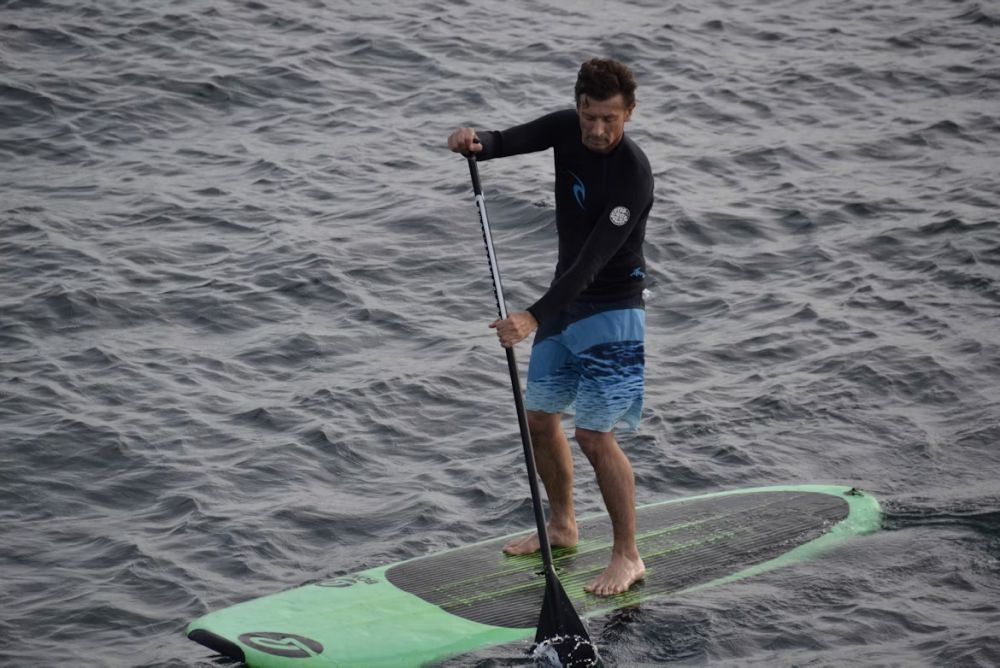
1. Turning the Tables:
When facing headwinds (wind blowing directly against you), the most efficient strategy is to turn into the wind and waves whenever possible. Angling your board at a 45-degree angle will present a smaller profile to the wind, reducing resistance and making paddling easier. However, be aware of choppy conditions and adjust your course accordingly.
2. Lowering Your Profile:
When encountering strong crosswinds (wind blowing perpendicular to your direction of travel), get lower on your board to minimize wind resistance. Kneeling or even lying prone can significantly improve stability and control. This technique also reduces your profile, making it harder for the wind to push you around.
3. Laying Flat:
If the wind is fierce and paddling in any position is difficult, consider laying flat on your board. This position presents the least wind resistance, maximizing stability. While not ideal for long distances, it can be a lifesaver in extreme situations to help you reach safety.
4. Equip a Surf Assistant with Boost Fin:
For experienced paddlers seeking additional assistance, a Boost Fin can be a valuable tool in windy conditions.
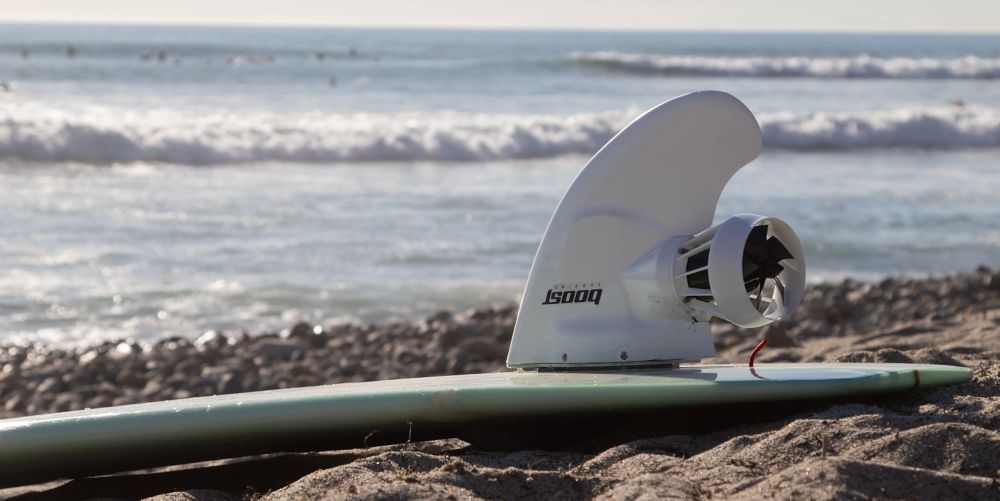
This lightweight, compact fin (with only 2.7 lb) boasts an impressive thrust of 20 lbs, making overcoming choppy waters and headwinds easier. The Boost Fin also utilizes a powerful thrust generated by a double battery and remote control. This feature can significantly assist in windy conditions with an incredible session time:
- SUP Assistance Mode: up to 100 minutes
- Trolling Mode: up to 70 minutes
- Wind/Current Resistance Mode: up to 40 minutes
If you’re wondering how to go fast on a paddle board, especially in challenging conditions, integrating a Boost Fin into your setup could be the game-changer you need. Its efficient design and powerful propulsion system can help you maintain speed and control, even when the wind is against you.
By understanding the challenges of wind sail for paddle board, adopting safe paddling practices, and utilizing the appropriate equipment like Boost Fin, you can navigate windy conditions with confidence in no time.
Paddle Boarding with Boost Fin
While ideal wind for paddle boarding generally falls below 5 knots, venturing out in windier conditions can be an exhilarating experience for seasoned paddlers. The innovative Boost Fin empowers you to navigate windy paddle board situations with greater control and stability.
Boost Fin’s unique design significantly reduces wind drift, allowing you to maintain your course and paddle efficiently even when facing headwinds. This translates to a more enjoyable and productive paddling experience, regardless of the wind’s direction.
However, it’s crucial to remember that Boost Fin is only available through authorized channels. Boost products from platforms like eBay are not as quality-guaranteed as those purchased directly from Boost Surfing or its official distributors.
By purchasing Boost Fin directly from our website or through our trusted partners, you can explore the possibilities to wind sail paddle board with confidence, knowing you have the right equipment by your side. Contact us if you have any questions regarding Boost Fin!


Compartilhar:
Single Fin Surfboards Guide: Pros and Cons
Surfboard Fin Setups Guide: Types and Placements